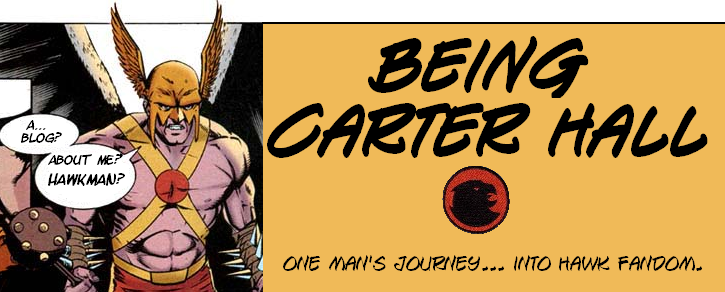Tuesday, February 10, 2009
Logo Study -- Hawkman V.1
Taking some inspiration from Todd Klein's fantastic logo studies over at his blog, I am going to take a sort of amateur approach to the various logos Hawkman has had over the years, and what I like and don't like about them.
I'm not an artist, not by a long shot. And I am also not a design guy, who has strong opinions about fonts and what not. Most times I end up using Courier New because that is the deafult font in my text editor. So don't expect a serious discourse about dropoffs-this and serifs-that. Because, honestly, that's not what I am about.
Alright, it took Hawkman a number of years to get his name on the front of a comic book. His Golden Age career in Flash Comics and All-Star Comics netted him cover appearances, but not a heading logo. Same goes for his Silver Age revival in The Brave And The Bold, Showcase, and Mystery In Space. But with the launch of his own title in 1964, it became necessary for him to have a flashy hook right on the cover, and so that brings us to our first logo.
Designed by veteran DC logo and house ad guru Ira Schnapp, the Hawkman logo is, at first glance, pretty staid compared to its contemporaries. The letters seem fairly simple and straightforward, and there are no unusual angles or italics. The tall letters appear almost elongated, and make the logo look thinner than other DCs from the same time, such as Superman or Green Lantern. Before I started reading Hawkman, I never gave the logo any thought.
Looking at it in more detail, I think the subtle strength of the logo becomes evident. First off, the "wingtips" on the top of the letters -- especially the two A's -- give a sense of fluidity and motion. Not as severe as the Flash logo, obviously, but enough to suggest in a very abstract way the motion of flight. This combines with the "foottips" on the bottom of each letter to form a nice sort of diagonal symmetry. There is not a real clear pattern on which side of the letters is beefier; for some it is the right hand side, for others the left. Having the letters be unbalanced in this way does offer a sign of strength, but when you look closely it's an odd effect.
The "diagonal symmetry" works well with the blunted tips of the letters, such as on the A's and the W, as well as the bottom of the M. Combined with the aforementioned long length of the letters and the overall effect suggests to my eye one of antiquity. Which, in the case of a character who uses ancient weapons to combat evil, and whose secret identity is that of a museum curator, is a good fit. Hawkman in the Silver Age was a science fiction character, no doubt, but this logo evokes the fact that he was also a character tied to history and ancient times.
As I said, before I started reading and collecting Hawkman I never gave his logo a second glance. But now, it leaps out to me on the basis of its quiet strength. It identifies the character as being different from his fellow science fiction brethren, eschewing certain "modern" touches for more "old timey" ones. Overall, I like this logo quite a bit, and it is no surprise that it served Hawkman for many years.
Subscribe to:
Post Comments (Atom)



3 comments:
This was a simple, elegant logo well suited to the character, which explains its longevity. They used that one until, what, Hawkworld?
I find these logo studies fascinating. Thanks for undertaking this look at the Hawkman logos! As Frank noted, this version appears strong, distinctive, and elegant in its simplicity. I look forward to seeing what you'll have to say about the others.
I am glad you guys enjoyed this study! Seriously taking stime and examining the logo was a fun exercise.
Hawkman had one additional logo between this one and Hawkworld, which will be the next installment: the title from The Atom And Hawkman.
Post a Comment